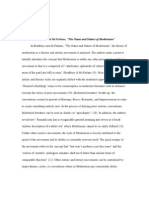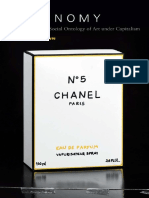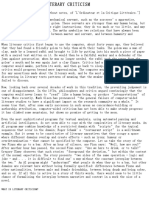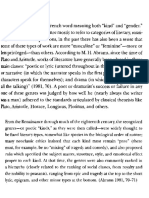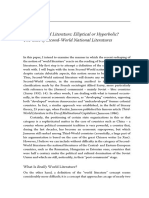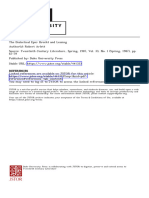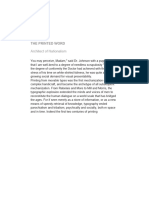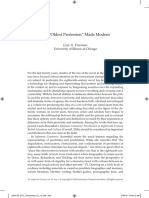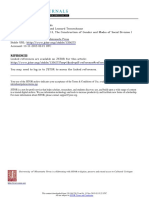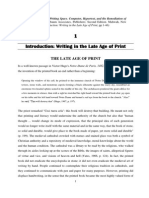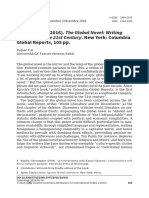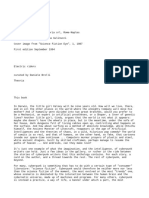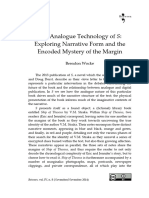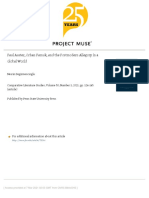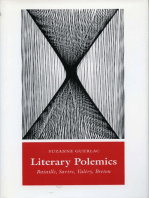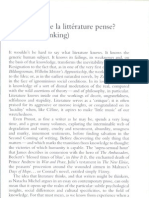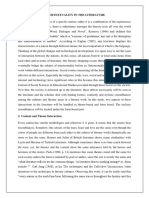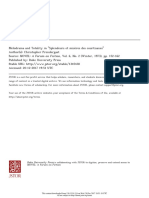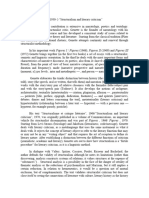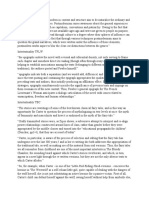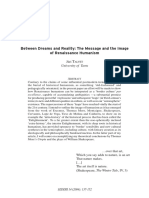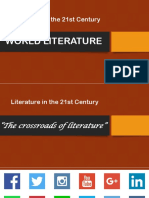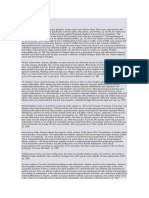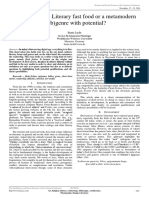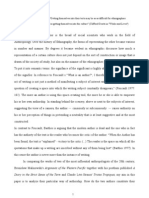Literary Secretaries Intro
Literary Secretaries Intro
Uploaded by
Nikos EliadesCopyright:
Available Formats
Literary Secretaries Intro
Literary Secretaries Intro
Uploaded by
Nikos EliadesCopyright
Available Formats
Share this document
Did you find this document useful?
Is this content inappropriate?
Copyright:
Available Formats
Literary Secretaries Intro
Literary Secretaries Intro
Uploaded by
Nikos EliadesCopyright:
Available Formats
Introduction
Invisible Hands
Leah Price and Pamela Thurschwell
In a world of processed words and mediated information, secretaries are both iconic and invisible. "Whatever they may do," one bibliographer has observed, "authors do not write books."! This volume focuses on the representation, self-representation and non-representation, in literature, film, and other cultural forms, of those who do write - manuscripts and memos, forms and faxes. The figure who writes in the place of another is by no means a recent invention, as Chaucer's "Wordes Unto Adam, His Owne Scriveyn" makes clear. Scribes, clerks, copyists, literary secretaries, private secretaries, and post-industrial data-entry workers all make the word flesh. Over the past two centuries, however, the nature of their agency has changed. The typewriter, the dictaphone, the xerox machine, and the personal computer have reshaped the organization of data and of the persons who process it. Literary Secretaries/ Secretarial Culture explores the paradoxes of that implicit job description, asking how the metamorphoses of the secretary intersect with the writing and reading of literature.
From the "tappity-tap-tap and the thin bell and muffled whir" that provide background noise for the opening scene of The Maltese Falcon to what U.A. Fanthorpe calls "the saddest dedication: lastly my wife, / Who did the typing," secretaries hover at the margins of modem literature - and literary theory. Moviegoers may remember Dracula for its blood and sex, but it is also a novel about typewriters and shorthand. Secretaries permeate high culture (think of the "privysuckatory Shem" of Finnegans Wake) and low culture (James Bond's Miss Moneypenny). More precisely, they figure the latter within the former. When the typist in The Waste Land "smoothes her hair with automatic hand / And puts a record on the gramophone," she acts out the split between the different kinds oflinguistic labor the poem embodies - between Eliot's artistic collaboration with Pound and the stenographer's more mundane interaction with a dictator, between inspired minds and automatic hands. Yet the secretary does not securely personify one of those two poles so much as negotiate between the two, making manifest the economic transaction that produces the aesthetic artefact. Henry James's secretary Mary Weld wrote in her diary not of the plot or style of The Wings of the Dove but rather the important fact that the book involved 194 days of dictation: a useful reminder that every great literary work of the twentieth century has been typed by someone for money or love or both.' (The same holds true for most twentieth-century writings about literature, at least until the advent of word processing software.)
2
Literary Secretaries/Secretarial Culture
How does the practice of (literal) writing affect the theory of (literary) writing - and the other way around? The information theorist Allen Renear has argued that literary-theoretical models are constantly reshaped by the unspoken protocols of "publishing, office automation, textual editing, text processing software.'? Yet it's not enough to argue against thinking about literary production and consumption in a vacuum without recognizing that ideas of the literary are formed not just by analogy with more mundane kinds of writing, but in opposition to them. (To place verbal artworks in dialogue with vernacular text processing practices is also to acknowledge how gingerly the two have acknowledged each other.) As the following chapters will suggest, the office doesn't just provide a safely distant dumping-ground for all those aspects of writing and reading which aesthetic experience filters out; it also provides literature with a safely distant space in which to explore (or onto which to refract) questions internal to its own theory and practice. In short, these essays ask not just how the systems of producing, storing, retrieving and disseminating information developed over the past two centuries have changed ideas about authorial agency, attribution, and originality (and vice versa), but also how that interplay - the invocation or interrogation of that analogy - has in turn changed understandings of the relation between verbal texts and material objects.
Has writing become a dead metaphor - or is it rather paralyzed, caught somewhere between artistic intention and mechanical reproduction? It could be objected that nothing but semantic coincidence links "writing" in the sense of producing material marks with "writing" in the sense of composing verbal content. Yet it could also be countered that the dissimilarity of those two terms is precisely what makes our culture define each in relation to the other. When Julian Huxley explained natural selection by analogy with the scene of millions of monkeys at millions of typewriters randomly generating Hamlet, he used the typist to stand for everything that Shakespeare was not. One is plural, the other singular; one copies, the other creates; one touches, the other thinks. (Truman Capote famously dismissed Jack Kerouac: "That's not writing. That's typing.") The opposite of genius is typist. The office encapsulates the very aspects of textual production whose absence demarcates the aesthetic: commercialism, collaboration, materiality, usefulness. Adorno's axiom that "culture originates in the radical separation of mental and physical work" finds its occupational corollary in the division of textual labor.
In short, an idea of the aesthetic that emerged in opposition to commercial culture has as its parallel a model of the author defined in contradistinction to the clerk. More surprisingly, perhaps, the modem office has defined itself against literature in tum. The twentieth-century business historian who dismisses filing by date as "positively Dickensian" mirrors the nineteenth-century secretarial training manuals that pepper their advice with the names of Tim Linkinwater and the Cheeryble brothers." If secretarial work provided literary writing with an analogue and an antithesis, conversely the office distanced itself from literature in the process of invoking it. One oxymoronically-titled Art of Typewriting published in 1905 uses an epigraph from Pope's Essay on Criticism to exclude what the manual calls "the unskilled class - those who have skimped through the elementary textbook of
Introduction
3
shorthand, and can just bang on the typewriter keys'<-or what another calls "illiterate operators ... far more fitted to wield a spade ... who know more about Pitman's shorthand and typewriting than they have ever known, or are ever likely to know, about the composition of the English language;" The 1901 British census which expelled shorthand writers from the category containing "authors and journalists" to another entitled "mercantile occupations" marked not just the social demotion of a group whose value dropped as its numbers increased, but also the extent to which writing had become the terrain contested in a larger battle between body and mind, or the economic and the aesthetic.
That demotion doesn't just involve class, of course, but gender. Feminists' perennial hope that writing could allow women to assert or find themselves clashes with the grim statistics suggesting that women remain precisely those for whom writing means wage-slavery rather than liberation, alienation rather than selfexpression. A few years before Roland Barthes died, an interviewer from Le Monde asked him whether he did all his writing by hand. Barthes answered "It's not that simple," before explaining why he had bought an electric typewriter.
Since I'm often very busy, I have sometimes been obliged to have things typed for me by others (I don't like to do this, but it has happened). When I thought about this, it bothered me. Without going into a big demagogical speech, I'll just say that to me this represented an alienated social relationship: a person, the typist, is confined by the master in an activity I would almost call an enslavement, when writing is precisely the field ofliberty and desire! In short, I said to myself: 'There's only one solution. I really must learn to type."?
Barthes looked forward to a future when intellectuals' secretarial turns could fudge the alienation of headwork from handwork by combining both functions in their own persons. But the spread of word processing after his death seems to have muddied that distinction without offering any solution to the "social relationship" that he describes. If literary criticism is now more often composed at the same time as it's keyed in, and by the same hand, that hasn't caused the salary or status differential between different classes of office workers to narrow. On the contrary, "office" is already becoming an anachronistic adjective for the vast majority of keyboarders operating in factory-like conditions. Where at the turn of the last century the dictaphone allowed secretaries to be grouped into typing pools whose layout minimized contact between the individuals giving and taking dictation, now satellite communications technologies have enabled First World corporations to outsource data entry to cheap labor elsewhere. Women in Barbados now key in everything from boarding passes to pornographic novels to academic monographs (one-twentieth of a cent per keystroke, 10,000 keystrokes minimum per hour). As keyboards replace sewing-machines in Philippine sweatshops, a geographical division of labor from management replaces the earlier bodily contact that made possible jokes like "Try this on your typewriter" - the caption to a photo of a woman sitting in a man's lap next to an unused machine."
4
Literary Secretaries/Secretarial Culture
Why is it important that the secretary be a person (instead of/as well as) a thing?
Like its spin-offs, the personal computer (PC) and the personal digital assistant (PDA), the term "personal secretary" transfers the adjective from the noun that it grammatically modifies to an unnamed user, stripping the secretary of personhood, let alone personality. But this is nothing new. Until the first decade of the twentieth century, as Fleissner and Olwell note, a "typewriter" referred to the worker as well as to her machine: only gradually was the term changed from a free-standing noun ("a lady type-writer") to an adjective ("a typewriter girl") and finally severed from any reference to human operators by the invention of an alternative term, the "typist."? (As readers of Our Mutual Friend will remember, "secretary" has moved in exactly the opposite etymological direction, from a term for a desk to a metonymy designating its occupant.) In 1897, Grant Allen peppered his eponymous novel with an encyclopedic range of possible designations: "type-writer girl," "type-writer (female)," "a lady to type-write for you." All that allows the operator to be distinguished grammatically from the machine is that one can be gendered and the other can't: "a lady typewriter" is clearly human whereas "a typewriter" could equally well be mechanical. But as "type-writer" goes from modifying gender designations to being modified by them, the reversal of noun with adjective determines whether the referent is a human who happens to type, or a writing instrument that happens to be human.
The case studies collected in Literary Secretaries exemplify the paradoxes of women's empowerment and subjection in the twentieth-century workforce. G.K. Chesterton (not a noted feminist) quipped, "Twenty million young women rose to their feet and said 'We will not be dictated to' and immediately became shorthand typists."!" Turn-of-the-century feminists associated standing up for one's rights with sitting down at one's desk; the history of the typewriter (human operator and machine) is bound to a history of the contestation and re-installation of gender roles. When Henry James hired Mary Weld from Miss Petheridge's Secretarial Bureau to replace his outgoing Scottish male secretary, William MacAlpine, he wrote the brutal truth in a letter: "MacAlpine's lady successor is an improvement on him! And an economy!'?' But "economy" is not everything, as Fleissner's essay cautions: given that women's labor is usually cheaper and that employers usually want cheaper labor, cost alone is not enough to explain why some fields become feminized at particular historical moments rather than others." The essays in this book draw on literature, film, and other cultural artefacts to interrogate the received understanding of the feminization of secretarial work at the end of the nineteenth century.
For economic as well as cultural reasons, these case studies cluster around the tum of the century. In Britain at least, the First World War consolidated the emergence of a clerical workforce that was larger, lower-paid, and more mixed in social origins as well as gender than a generation before - changes that historians have explained by factors as various as corporate mergers, the 1870 Education Act, and the commercialization of the typewriter and the phonograph along with lowertech inventions such as the filing cabinet and the index card. In one modem scholar's estimate, the number of women filling clerical jobs multiplied more than 80 times between 1850 and 1914, going in the same period from 2 percent to 20 percent of the
Introduction
5
total number of British clerical workers. 13 Yet, however often those statistics reappear in contexts ranging from women's studies courses to (male-dominated) listservs for antique typewriter collectors, it's striking how exclusively they're framed as changes in women s position - whether for better or worse. Several of the following essays turn that question around, exploring the problems that the feminization of clerical work posed for masculine authorship (Karlin, Kreilkamp), for male clerical workers (Fleissner) or for men's leisure reading (Price). Early twentieth-century conservatives worried that working side by side with men in public would unsex women, but the intervening 100 years have not borne them out. (The history of sexual harassment dovetails neatly with the feminization of secretarial work.)" On the contrary, it is when machines promise to replace bodies that the secretary becomes sexualized (think of Fawn Hall with the paper shredder and the big hair, or Melanie Griffiths' changing outfits in Working Girl) or extravagantly embodied (witness Dolly Parton in the earlier movie Nine to Five, a title shared with the name of a labor organization). In the joke of the boss with his "typewriter" on his lap, the confusion of woman with machine offers no safe harbor from sex stereotyping, but rather creates new erotic demands and imagined supplies. If the secretary's mind is sometimes pictured as disposable, a machine for mechanical reproduction, her body is simultaneously consolidated as easily accessible on-site. In fact, Working Girl and Nine to Five both revolve around the too-smart secretary whose abundant brains are eventually revealed under her too-evident body - the structuring contrast between the head made for business and the body built for sin, as Melanie Griffiths' character puts it. The reward usually takes the form of leaving the secretarial position behind - moving up and out of the nine-to-five punch card typing pool (which both films represent as a communal and often supportive female space) to displace the boss (as Lily Tomlin does in Nine to Fives." Whereas the fictional representations of secretarial lives discussed by Fleissner pictured the ideal trajectory as from the office back to the domestic space of the home, the cinematic secretary usually makes the shorter journey to a cubicle of her own.
An alternative story about data entry in the twentieth century, however, would involve the progressive divorce of copying from reading. The first generation of typewriters, whose type bars hid the page from view, forced operators to key in each new line without re-reading for sense the text that came before it. When Remington experimented with repositioning the type bar at the turn of the century, manufacturers of the older models fought back by claiming that re-reading their own words would slow typists down. In the words of one advertisement for an older model, "the writing [on the page] being concealed, the notes [being copied] receive whole attention.'?" At the very moment when the triumph of "visible" typewriters allowed typists to read for context, the commercialization of the dictaphone prevented them from reading for content: the centralization of typing pools made possible by new recording technologies prevented anyone typist from obtaining the kind of intimate knowledge of a single employer's business that allowed telegraph boys to blackmail, or private secretaries to plagiarize." Here again, digital sweatshops provide a telling parallel. In the 1970s, the first US data entry brokers sought out
6
Literary Secretaries/Secretarial Culture
former British colonies like Barbados and India. By the 1990s, though, their strategy was just the reverse. What drove employers to Mexico and the Philippines was not just the fear of unionization, but the quest for an allophone workforce. "Offshore workers go faster," according to one company that contracts US companies' data entry needs to Mexican maquiladoras, "because they don't understand what they're keyboarding.?" The ideal worker becomes a non-reading writer.
Billed as cutting down human error along with costs, the export of data entry across linguistic borders projects the spatial segregation of the typing pool onto the face of the globe. From the anteroom of Victorian counting-houses, to a different floor of a Manhattan skyscraper, to a different part of the anglophone world, keyboarding finally migrates across linguistic borders. 19 But then, linguistic difference has always allowed workers to transmit information without receiving it: as early as the Great War, stenographers volunteered to take down interrogations of war prisoners in Isaac Pitman's "phonetic" system without compromising the state secrets of which they could have no conscious knowledge." When Etta Cone agreed to type-up the handwritten manuscripts of Three Lives for her friend Gertrude Stein, she began slowly, typing out letter after letter, until Stein gave her official permission to read the contents - at which point the work progressed much faster. Stein herself was often accused of ignoring content in favour of sheer linguistic materiality. Here we see what happens when a typist follows her lead. That fantasy of divorcing transmission from understanding culminates in William Gibson's recent cyberfiction "Johnny Mnemonic," whose title character rents his brain on an "idiot/savant basis" that denies him access to its encoded contents. Because the information passes through its human storage space without leaving any trace, no commercial rival can "drug it out, cut it out, torture it out" - a new solution to the old quest for a form of data that can be processed without being appropriated or betrayed."
This lack of trace, this ideal of perfect mediation, may help explain the role that secretaries play in competing strands of contemporary literary theory. The women who stand between mental and manual (or white-collar and blue-collar) modes of labor also occupy the threshold between metaphysical and material understandings of language. In the wake of Friedrich Kittler's work on "discourse networks" - the medical, technological, scientific, and literary discursive systems at a given historical moment that connect apparently disparate subjects such as writing technologies to the formation of human subjectivity - deconstructive explorations of the relations between speech and writing have begun to engage with historical research on material technologies of communication. The secretary can be located at one intersection of these contrasting approaches: mediating between historical questions about class, gender, technology and economics, and philosophical questions about - well - mediation. The secretary's supplemental position in the office reveals the inability of the boss's name to signify an authentically occupied identity (those pp.s at the bottom of the letter give the game away). Speech and writing, the loss of, and nostalgic longing for, full agency, seem to meet in her job description. The temptation is to reduce the secretary in the abstract to a high theory box of metaphorical delights, a mantelpiece from which to hang many purloined (and cc.ed) letters."
Introduction
7
As a corrective, it's important to remember how unimaginable the secretary who figures in late-twentieth-century literary theory would be without early-twentiethcentury fiction and film. The persons and machines that produce texts are themselves a product of textual machinery: of the ad campaigns that spurred businesses to want new supplies and services, and of the literature (from serialized romances to New Woman polemics) that lured thousands of women into indebting themselves to buy typewriters or obtain diplomas. Secretaries' images, as well as their services, have always been bought and sold. Their ubiquity in turn-of-the-century media registers warring contentions about the condition of modem women. Was the secretary a sexually adventurous, independent feminist, or an economically depressed drudge looking for a way back into domesticity via marriage? What stories about the female bourgeois subject made these two seem like mutually exclusive options? And how have these stories changed - or resurfaced - in an age of digital reproduction?
The collection begins with a reminder that men also performed (and perform) secretarial labor, and that the iconic late-nineteenth-century female secretary is preceded by the mid-century male clerk. Stenography holds a central place in Ivan Kreilkamp's approach to Dickens, probably the most famous figure ever to combine the secretarial and authorial roles in one person. Yet the triumphalist narrative of Dickens's rise from stenographer to journalist to author is undercut, as Kreilkamp shows, by David Copperfield's parody of the improbably utopian claims made by early-Victorian shorthand manuals. If, in the era of Johnson's Dictionary, standard English was thoughtto reform the arbitrary profusion of speech, in the early nineteenth century shorthand manuals like those from which Dickens himselflearned reporting offered to cure the historical contingency of English. The how-to manuals that Kreilkamp examines claim to provide not simply an efficient system of information storage, but a means by which writing might be infused with the fleeting moment of vocal articulation. David's skill in shorthand promises (without quite succeeding) to lend him not just a new kind of professional authority, but control both over the feminine evasiveness of speech and over his wife. In Kreilkamp's reading, the errant voice becomes at once the object of desire and the threat to meaning; the sign system of shorthand can be read either as a tool of professional authority or as an arbitrary code associated with ancient hieroglyphics.
Leah Price's chapter traces another unexpected link between shorthand and the vicissitudes of male professionalization, uncovering a vast (and understandably unstudied) tum-of-the-century canon reprinted in shorthand. By 1900 two shillings would buy the Old and New Testaments in shorthand, Swedenborg in shorthand, A Christmas Carol in shorthand, English-Welsh and English-Hindi dictionaries in shorthand, Gulliver s Travels, Tom Brown s Schooldays, Around the World in Eighty Days, highlights from Washington Irving, and all of the Sherlock Holmes stories as well as a digest of the magazine in which they appeared. Not only do "phonographic" publishers juxtapose biographies of Calvin and Galileo with fictions of Protestant self-help like Pilgrim s Progress, but their teach-yourself-accounting books find a counterpart in classics of autobiographical book-keeping like Robinson Crusoe and Franklin's Autobiography. Shorthand editions didn't just ratify the increasingly sharp
8
Literary Secretaries/Secretarial Culture
polarization of contemporary popular fiction according to the gender of its intended readers; by reprinting eighteenth-century authors like Defoe, Swift, and Franklin, they also invented a prehistory for the new transatlantic genres of boys' romance. What shorthand adventure stories share with secretarial how-to manuals, Price argues, is a narrative of masculine mobility (either upward or outward) increasingly foreign to desk-bound clerks in dead-end jobs, no matter what their gender. The marketing of shorthand to boys coincides with the moment at which social critics began to figure the mass public as a clerical worker, and more specifically as a male clerk. Shorthand reprints provide one clue, then, to what it means for men to write and read in a society when the movement of a hand across the keyboard or eye across the page is coming to be coded female.
Jennifer Fleissner's article on Dracula approaches that "female" coding from a different angle. Fleissner questions recent feminist re-evaluations of the novel that see Mina Harker's active secretarial role as progressively contained by the dynamics of the novel. These critics argue that although Mina begins the vampire hunt aspiring to be like the lady journalists she emulates, the task of keeping and interpreting the piles of vampiric information turns her into first a helpless vamped female, and finally, a fully domesticated mother. By contrast, Fleissner suggests that Mina's trajectory can be read very differently as part of an acceptable narrative of the life of a middle class working woman; the journey from secretarial reproductive labor to sexual reproductive labor is one that women were encouraged to take, one path by which the apparently "new" woman could go home again. Fleissner notes the ways in which Mina's leading role in the book is presented as simultaneously active and unconscious. Hypnotically tapping her mind provides the male vampirehunters with information about Dracula's whereabouts, but Mina is unable to prevent Dracula from similarly using her breachable brain to gain information about their movements. In this doubled image of Mina as active agent and passive medium, she resembles one image of the ideal turn-of-the-century secretary as the woman who "knows how not to know," who is thus able to transmit information without being "exposed" to it. Fleissner's explanation also enables us to understand two seemingly opposed rationales offered for women's entry into clerical work via the suitability of the newly-deployed typewriter. Fleissner asks "how could the 'feminine' aspect of [secretarial] work be at once a matter of the machine-like nature ofwomen's bodies, and a tribute to their charm and social know-how?" The claim that women were more suited to repetitive, mechanical work could be resolved with the depiction of the secretary as a domestic hostess figure, one who was actively preparing for, not avoiding, the conventional role of wife and mother. If, as Fleissner suggests, the feminization of secretarial work threatened notions of separate spheres, then by training to be the perfect secretary one could also imagine oneself training to be the perfect wife. At the precise moment at which the female clerical worker's image shifted from posing a threat to the family to providing a support for domestic ideology, Mina Harker embodied the unbeatable combination of wife, mother, and writing machine. In her, Stoker created a paradoxical genius of the automatic and unconscious - the ultimate working (but uncorruptible) secretarial body.
Introduction
9
The typing body is the concern of Victoria Olwell's article as well. The year in which Dracula appeared, 1897, also saw the publication of another typewriting novel, Grant Allen's The Type-Writer Girl. Olwell's article uses Allen's novel to explore the ways in which typewriting was imagined as de-corporealizing writing, only to recorporealize it in the conspicuously sexualized, yet simultaneously automatized, body of the female typist. Through reading fin-de-siecle works of typewriting pedagogy, Olwell makes a case for linking the new machine-age, "automatic" woman with the earlier stereotype of the feminine as "nature" to masculine "culture"; the typist who could speed type accurately was often shown in the "how-to" literature as possessing an instinctive link between the muscles of her nervous system and the alphabet on the keyboard. Olwell refracts Allen's novel through his impassioned engagement, in his newspaper and journal articles, with current debates about the enfranchisement of women and the evolutionary degeneration of the race. Culturally-shared anxieties about the loss of modem women's ability to bear children because of the dangers of excessive education surface in Allen's portrayal of his Girton-educated, smart and sassy, but significantly single type-writer girl, Juliet Appleton. Allen's conflicting views on women's place in modernity and in the body politic can be seen in finde-siecle culture's contradictory expectations of female typists, those mediating bodies and minds so in danger of disappearing behind the perfectly mechanized typewriters with which they seemed to become (linguistically and metaphorically) co-extensive.
The secretarial mediums of Bette London's article are concerned with a different kind of disappearing body, that of the dead author: for in the early twentieth century, some secretaries found themselves taking orders from beyond the grave. London explores the case of Louise Owen, private secretary to the newspaper magnate and mass populiser Lord Northcliffe, who received messages from him via seances and automatic writing for years after his death. London shows the ways in which the qualities that make for a successful private secretary to a public figure - the taking on of the other's voice, the anticipation of his or her every need - are precisely the qualities that make for a successful medium. London places Owen's story - which ended unhappily for her in her bankruptcy after a contested lawsuit over Northcliffe's post-death legacy - in the context of the many other mediums at the time who were receiving posthumous dictations from the literati of the previous century. Northcliffe's case, like that of another post-death dictating newspaper man, W.T. Stead, illustrates the ways in which trance mediumship and secretarial labor were brought into dialogue with a continuing concern for communicating with "the man and woman in the street.':" London's exploration of the post-death return of the populiser Northcliffe via his private secretary shows the ways in which Owen's career can shed light on the complicated path to professional recognition that some women at the time were finding as "secretaries to the stars."
Daniel Karlin's chapter, "The Case of the Capable Fingers," examines the role of the secretarial sidekick in Erle Stanley Gardner's Perry Mason detective stories, as well as in successive biographies of their creator. In fiction by Gardner as well as non-fiction about him, the secretary personifies what Gardner himself called the
10
Literary Secretaries/Secretarial Culture
"Fiction Factory," an "assembly line" in which dictating, typing, and revising were delegated to a series of different hands. Yet in retrospect, Gardner's representation of his early life upstages the secretarially-lubricated assembly line by a one-man sweatshop: that is, Karlin reveals the industrial production made visible by writing machines and human typists as the effect rather than the cause of Gardner's massmarket success. And the secretary's role shifts just as drastically over the course of the 85 Perry Mason books as it did over the course of Gardner's 40 year writing career; as successive stories overwrite the early novels' hints at a sexual relation between Mason and his secretary Della Street, they also change her from central character to marginal observer. It's as an employer rather than a husband, Karlin shows, that Mason (and Gardner) can negotiate the contradictions of masculine authorship.
Douglas Brooks's final chapter offers a counter-intuitive history of the alphabet that raises questions about the relationship between writing technologies and embodiment, and the gendered ways in which the act of writing has been historically imagined. In an argument that weaves its way from the invention of parchment codex to Chaucer to the recent outsourcing of the transcription of medical records to third world countries, Brooks suggests that the body, in particular the reproductive female body, is never far absent from technologies of transcription. For Brooks, the metaphor that equates the woman with the white sheet of nature onto which a male stylus can transcribe was present in the material/technological origins of writing itself. Revisiting Heidegger's "disquisition on the typewriter," Brooks speculates about the implications for "being" in the not-too-distant future when voice recognition software may render obsolete our current models of secretarial mediation, along with the hands, scribes, and word processors that have historically done the labor of writing. If improved voice recognition technology threatens the complete disembodiment, and indeed, erasure, of secretarial labor, then, Brooks suggests, it may be significant that this kind of technology emerges at a moment when the female body as the locus of sexual reproduction is also being challenged. The collection concludes by asking what the future holds for the modem secretary. What new economic and technological conditions have transformed secretarial labor into something that its nineteenth-century practitioners would be hard put to recognize? Now that we are past the age of typewriters, and typewriter girls, what is the future of textual mediation?
Notes
Roger E. Stoddard, "Morphology and the Book from an American Perspective," Printing History 17 (1987): 2-14; 4.
2 H. Montgomery Hyde, Henry James at Home (London: Methuen & Co. Ltd, 1969) 150. 3 Allen Renear, "Out of Praxis: Three (Meta)Theories of Textuality," Electronic Text:
Investigations in Method and Theory, Kathryn Sutherland, ed. (Oxford: Clarendon P, 1997) 107-126; 107.
Introduction
11
4 Martin Campbell-Kelly, "The Railway Clearing House and Victorian Data Processing," Information Acumen: The Understanding and Use of Knowledge in Modern Business ed. Lisa Bud-Frierman (London: Routledge, 1994) 51-74; 70.
5 George Carl Mares, The Art of Typewriting (London: Guilbert Pitman, 1905) 12. Another manual, which Fleissner's essay in this volume discusses in greater detail, makes the distinction even more explicit by calling attention to the structure of its own chapter divisions: "There is a wide gap between the stenographers and clerks of the previous section and the secretaries of this ... It is the workers rather than the employers who chiefly fail to realise this, and so miss many of their opportunities" (M. Mostyn Bird, Woman at Work: A Study of the Different Ways of Earning a Living Open to Women [London: Chapman and Hall, 1911] 133-34). The introduction of word processing in the 1970s at first widened the gulf separating copyists from typists by dividing a previously homogenous class of secretaries into "correspondence" and "administrative" categories: see Elena Softley, "Word Processing: New Opportunities for women office workers?" in Wendy Faulkner and Erik Arnold, Smothered by Invention (London: Pluto, 1985),222- 237; 229.
6 "Some Points about the Typist," Writing Machine News 5 (May 1900): 39.
7 Roland Barthes, "An Almost Obsessive Relation to Writing Instruments" (1973), The Grain of the Voice (London: Jonathan Cape, 1985) 177-79; 179
8 For a provocative discussion of this advertisement, see Christopher Keep, "The Cultural Work of the Type-Writer Girl," Victorian Studies 40:3: 401-26; 417.
9 A book published in 1909, for example, already refers to "typewriter operators, or typists, as it has become fashionable to call them" (George Carl Mares, The History of the Typewriter [London: Guilbert Pitman, 1909] 10). For a more detailed discussion of the lexical problems, see Leah Price, "Grant Allen and the Division of Literary Labor," Grant Allen and Cultural Politics at Fin de Steele, eds. William Greenslade and Terence Rodgers (Aldershot: Ashgate, forthcoming).
10 Attributed to G.K. Chesterton in Wilfred A. Beeching, The Century of the Typewriter (Bournemouth: British Typewriter Museum Publishing, 1990) 34.
II Qtd. in Leon Edel, Henry James: The Master 1901-1916, (London: Avon Books, 1974) 94.
12 See Samuel Cohn, The Process of Occupational Sex-Typing: The Feminization of Clerical Labor in Great Britain (Philadelphia: Temple UP, 1985).
13 Meta Zimmeck, "Jobs for Girls," Unequal Opportunities: Women s Employment in England 1800-1918, ed. Angela John (Oxford: Blackwell, 1986) 153-78. See also David Lockwood, The Black-Coated Worker: a Study in Class Consciousness (Oxford:
Clarendon P, 1989).
14 By contrast, Friedrich Kittler asserts that "In the discourse network of 1900 - this is its open secret - there is no sexual relation between the sexes" (Discourse Networks 1800/1900, trans. Michael Metteer with Chris Cullens [Stanford: Stanford UP, 1990] 357). Kittler's otherwise compelling argument about the association of women with mechanical reproduction in the tum of the century marketplace here simplifies the proliferation of new sexual possibilities - in reality or fantasy - opened up by the influx of women into the office. See also Pamela Thurschwell, "On the typewriter, In the Cage, at the Ouija Board" in Literature, Technology and Magical Thinking, 1880-1920 (Cambridge: Cambridge UP, 200 I) 86-114; 94, and Thurschwell, "Supple Minds and Automatic Hands: Secretarial Agency in Early Twentieth-Century Literature" Forum for Modern Language Studies 37.2 (2001): 155-168.
12
Literary Secretaries/Secretarial Culture
15 Nine to Five (1980) makes an interesting case study in the image of secretarial workers. It separates the over-sexualized secretarial body of Dolly Parton (whose primary concern is making a living to support her husband and kids) from the sexless mastermind (played by the lesbian icon Lily Tomlin) who winds up taking over the boss's job.
16 Mares, Typewriter 91. On the Barlock's design, see Bruce Bliven, The Wonderful Writing Machine (New York: Random House, 1954) 89.
17 On plagiarism, see Leah Price, "From Ghostwriter to Typewriter: Delegating Authority at Fin de Siecle," The Faces 0/ Anonymity: Anonymous and Pseudonymous Publication/rom the Sixteenth to the Twentieth Century (New York: Pal grave Macmillan, 2003) 211-231. 18 Debbie Nathan, "Sweating out the Words," Nation 270 (21 February 2000): 27-30; 28. 19 See Rey Chow, Writing Diaspora: Tactics 0/ Intervention in Contemporary Cultural Studies (Bloomington: Indiana UP, 1993) 176-180; Fred Davis, "Electronic Immigrants:
Cheap Labor without Green Cards," PC Week 8 (3 June 1991): 142; and Carla Freeman, High Tech and High Heels: Women, Work, and Pink-Collar Identities in the Caribbean (Durham: Duke UP, 2000).
20 Alfred Pitman, Half a Century 0/ Commercial Education and Publishing (Bath: Pitman, n.d.) 83.
21 William Gibson, "Johnny Mnemonic" (1981), Burning Chrome and Other Stories (London: HarperCollins, 1999) 14-36; 23.
22 See The Seminar 0/ Jacques Lacan, Book II: The Ego in Freud's Theory and in the Technique of Psychoanalysis 1954-1955, trans. S. Tomaselli, ed. J-A Miller (Cambridge:
Cambridge UP, 1988) and Jacques Derrida, The Postcard: From Socrates to Freud and Beyond, trans. Alan Bass (Chicago: U of Chicago P, 1987).
23 Roger Luckhurst discusses the way in which W.T. Stead's "new journalism" combined his popular press and occult interests; the powers of the press over the reading public were conceived as akin to mass hypnosis (The Invention of Telepathy 1870-1901 [Oxford:
Oxford UP, 2002] 133).
You might also like
- Bradbury and Mcfarlane, "The Name and Nature of Modernism"Document5 pagesBradbury and Mcfarlane, "The Name and Nature of Modernism"ashleysivagamimohan100% (1)
- Autonomy The Social Ontology of Art Under Capitalism by Nicholas BrownDocument249 pagesAutonomy The Social Ontology of Art Under Capitalism by Nicholas BrownHalissonjrNo ratings yet
- Price+intro+Invisible HandsDocument12 pagesPrice+intro+Invisible HandsMartin JeanNo ratings yet
- Computer and Literary CriticismDocument7 pagesComputer and Literary CriticismGatot PitonoNo ratings yet
- Cities - Re Imagining The Urban ReviewDocument2 pagesCities - Re Imagining The Urban ReviewlightwriterNo ratings yet
- GenreDocument5 pagesGenrePedialy AvilesNo ratings yet
- Levinson, Ends of LiteratureDocument14 pagesLevinson, Ends of LiteratureSam SteinbergNo ratings yet
- Reading World Literature: Elliptical or Hyperbolic? The Case of Second-World National LiteraturesDocument10 pagesReading World Literature: Elliptical or Hyperbolic? The Case of Second-World National LiteraturesTonia MaNo ratings yet
- On The Track of Things: Sensation and Modernity in Mary Elizabeth Braddon'S Lady Audley'S SecretDocument19 pagesOn The Track of Things: Sensation and Modernity in Mary Elizabeth Braddon'S Lady Audley'S SecretAdwar AlKhamesiNo ratings yet
- 441333Document14 pages441333debarati110699No ratings yet
- Marshall McLuhan - The Printed WordDocument11 pagesMarshall McLuhan - The Printed WordZehra MutluNo ratings yet
- The Oldest ProfessionDocument7 pagesThe Oldest ProfessionEniko BodisNo ratings yet
- University of Minnesota Press Is Collaborating With JSTOR To Digitize, Preserve and Extend Access To Cultural CritiqueDocument51 pagesUniversity of Minnesota Press Is Collaborating With JSTOR To Digitize, Preserve and Extend Access To Cultural CritiqueHaneen Al IbrahimNo ratings yet
- Bolter - Writing Space 1-46 PDFDocument46 pagesBolter - Writing Space 1-46 PDFJuan RiveraNo ratings yet
- Art 10.14277 Tol 2499 5975 2018 20 035 - u6Avh1YDocument6 pagesArt 10.14277 Tol 2499 5975 2018 20 035 - u6Avh1YaylinsancaktarNo ratings yet
- Cavalieri Elettrici by A Cura Di Daniele Brolli (Google Translated)Document85 pagesCavalieri Elettrici by A Cura Di Daniele Brolli (Google Translated)jurgen cracknellNo ratings yet
- 1313-Article Text-4969-2-10-20150507Document21 pages1313-Article Text-4969-2-10-20150507Dante SartorisNo ratings yet
- Black Rain - Atomic Bomb LiteratureDocument7 pagesBlack Rain - Atomic Bomb LiteratureBurcu KocyigitNo ratings yet
- Darko Suvin - Sociology of Science FictionDocument12 pagesDarko Suvin - Sociology of Science FictionMelissa CammilleriNo ratings yet
- Digital PoetryDocument19 pagesDigital PoetryrodicagNo ratings yet
- Art ObjectDocument6 pagesArt ObjectEmo KhanNo ratings yet
- A Global WorldDocument23 pagesA Global WorldshushengNo ratings yet
- Concept of Narration in PostmodernismDocument9 pagesConcept of Narration in PostmodernismShabari ChoudhuryNo ratings yet
- F R Leavis - Literature and SocietyDocument12 pagesF R Leavis - Literature and SocietymaayeraNo ratings yet
- Modernism in LiteratureDocument11 pagesModernism in Literaturevewofib454No ratings yet
- 15Document19 pages15Betty MiklósNo ratings yet
- Alain Badiou - Qu Est-Ce Que La Litterature PenseDocument7 pagesAlain Badiou - Qu Est-Ce Que La Litterature PenseDaniel RedNo ratings yet
- Rethinking Past PresentDocument14 pagesRethinking Past PresentdomingodemoyaNo ratings yet
- Intertextuality DC XIIIDocument5 pagesIntertextuality DC XIIIMohan KalawateNo ratings yet
- Comentario de Textos Literarios en Lengua Inglesa: Unit 1 Post-StructuralismDocument10 pagesComentario de Textos Literarios en Lengua Inglesa: Unit 1 Post-StructuralismJuanviJuanviNo ratings yet
- Writers PersonalDocument4 pagesWriters PersonalMike ReyesNo ratings yet
- Notes - Globalization and Literature - June 11Document6 pagesNotes - Globalization and Literature - June 11Luisa GomezNo ratings yet
- With Culture in Her HandDocument6 pagesWith Culture in Her HandCamila CarvalhoNo ratings yet
- Individual and Community in The Scarlet LetterDocument10 pagesIndividual and Community in The Scarlet LetterJuan Angel CiarloNo ratings yet
- Duke University Press NOVEL: A Forum On FictionDocument12 pagesDuke University Press NOVEL: A Forum On FictionahorrorizadaNo ratings yet
- The Revenge of Karl Marx: Books April 2009Document5 pagesThe Revenge of Karl Marx: Books April 2009Rahul krishnanNo ratings yet
- Gérard Genette, Structuralism and Literary CriticismDocument15 pagesGérard Genette, Structuralism and Literary CriticismScribdTranslationsNo ratings yet
- The Death of Roland Barthes, Problems of 'Author' and 'Authority' in Contemporary Literary CriticismDocument13 pagesThe Death of Roland Barthes, Problems of 'Author' and 'Authority' in Contemporary Literary CriticismtirangamanviNo ratings yet
- Rancière - 2004 - The Politics of LiteratureDocument12 pagesRancière - 2004 - The Politics of LiteraturemeeresliedNo ratings yet
- Background and ContextDocument2 pagesBackground and ContextNatasa TucevNo ratings yet
- Essay QuotesDocument5 pagesEssay QuotesAna Martínez RamonNo ratings yet
- Gale Researcher Guide for: British Creative Nonfiction: The Development of the GenreFrom EverandGale Researcher Guide for: British Creative Nonfiction: The Development of the GenreNo ratings yet
- BIRCHALL, Ian H. Marxism and LiteratureDocument17 pagesBIRCHALL, Ian H. Marxism and LiteraturepgcNo ratings yet
- Waugh 5 What Is 4Document4 pagesWaugh 5 What Is 4Adrian DiazNo ratings yet
- Between Dreams and Reality The Message and The Image of Renaissance HumanismDocument16 pagesBetween Dreams and Reality The Message and The Image of Renaissance Humanismanon_243369186No ratings yet
- Literature in The 21st Century 2Document40 pagesLiterature in The 21st Century 2Kclyn Tano100% (1)
- Sin Título 6Document11 pagesSin Título 6EnriqueNo ratings yet
- Rise of NovelDocument7 pagesRise of NovelalexNo ratings yet
- Brian Kim Stefans. Conceptual Writing: The L.A. Brand. 2014Document16 pagesBrian Kim Stefans. Conceptual Writing: The L.A. Brand. 2014romanlujanNo ratings yet
- Historiographic Metafiction linda hutcheonDocument30 pagesHistoriographic Metafiction linda hutcheonbestecolak15No ratings yet
- Flash Fiction - Bente Lucht PDFDocument4 pagesFlash Fiction - Bente Lucht PDFAgostina SolísNo ratings yet
- Ethnographic WritingDocument24 pagesEthnographic WritingHéctor LópezNo ratings yet
- STL lesson 01Document6 pagesSTL lesson 01yacenmoulaNo ratings yet
- N@CDocument4 pagesN@CnarayananakhilaNo ratings yet
- Popular LiteratureDocument8 pagesPopular LiteratureClarisse Madayag100% (1)
- Roland BarthesDocument10 pagesRoland Bartheshpowers1968No ratings yet
- WagnerDocument19 pagesWagnermartinezevolet12No ratings yet
- University of Wisconsin PressDocument10 pagesUniversity of Wisconsin PressBar KobachNo ratings yet
- Instant ebooks textbook Autonomy: The Social Ontology of Art under Capitalism Nicholas Brown download all chaptersDocument37 pagesInstant ebooks textbook Autonomy: The Social Ontology of Art under Capitalism Nicholas Brown download all chaptersjirenekt100% (2)
